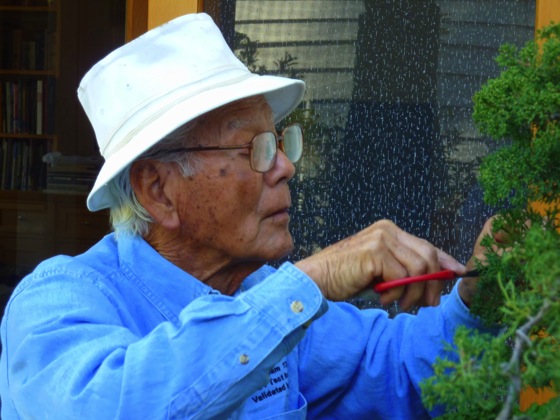Interesting Plant: Japanese Maple (Acer palmatum)
Growing up in rural Ohio, I was surrounded by maple trees of all shapes and sizes. There were the huge 100+ year old maples that overarched the main streets and also the large “sugar bush” lots where maple sap (and then maple syrup) remerged each Spring. When I moved to Los Angeles 28 years ago, I was somewhat disappointed that maples were few and far between here. The traditional east coast maple trees do not grow well here at all, requiring a period of deep cold to thrive. After several years, though, I discovered a new maple to love, the Japanese Maple (Acer palmatum). I have come to love these maples even more than those in my native state. They come in an almost infinite array of shapes, sizes, leaf coloration and shape and, thankfully, grow quite well here in Southern California. If I ever have the chance to start a garden from scratch, I would certainly use Japanese Maple as the focal points.
Acer palmatum, called Japanese Maple or Smooth Japanese Maple (Japanese: irohamomiji, イロハモミジ, or momiji, 紅葉) is a species of woody plant native to Japan, North Korea, South Korea, China, easternMongolia, and southeast Russia.[2] Many different cultivars of this maple have been selected and they are grown worldwide for their attractive leaf shapes and colours.
Acer palmatum is a deciduous shrub or small tree reaching heights of 6 to 10 m (20 to 33 ft), rarely 16 metres (52 ft), often growing as an understory plant in shady woodlands. It may have multiple trunks joining close to the ground. In habit, it is often shaped like a hemisphere (especially when younger) or takes on a dome-like form, especially when mature.[3] The leaves are 4–12 cm long and wide, palmately lobed with five, seven, or nine acutely pointed lobes. The flowers are produced in small cymes, the individual flowers with five red or purple sepals and five whitish petals. The fruit is a pair of winged samaras, each samara 2–3 cm long with a 6–8 mm seed. The seeds of Japanese maple and similar species require stratification in order to germinate.[3][4]
Even in nature, Acer palmatum displays considerable genetic variation, with seedlings from the same parent tree typically showing differences in such traits as leaf size, shape, and colour.[3]
Three subspecies are recognised:[3][4]
- Acer palmatum subsp. palmatum. Leaves small, 4–7 cm wide, with five or seven lobes and double-serrate margins; seed wings 10–15 mm. Lower altitudes throughout central and southern Japan (not Hokkaido).
- Acer palmatum subsp. amoenum (Carrière) H.Hara. Leaves larger, 6–12 cm wide, with seven or nine lobes and single-serrate margins; seed wings 20–25 mm. Higher altitudes throughout Japan and South Korea.
- Acer palmatum subsp. matsumurae Koidz. Leaves larger, 6–12 cm wide, with seven (rarely five or nine) lobes and double-serrate margins; seed wings 15–25 mm. Higher altitudes throughout Japan. — Wikipedia.org
Previously in the Interesting Plant series:
- Kousa Dogwood (Cornus kousa)
- Giant Chalk Dudleya (Dudleya brittonii)
- Sunrose (Helianthemum nummularium)
- Australian/New Zealand Tea Tree (Leptospermum scoparium)
- Brugmansia Sanguinea
- Calico Monkeyflower (Mimulus pictus)
- Colocasia Esculenta
- Acer palmatum ‘Sango-kaku’ (Coral Bark Japanese Maple)
- Linderniaceae (formerly Torenia) Kuaui Deep Blue
- Passiflora (Passion flower)
- Firewheel Tree (Stenocarpus sinuatus)
- Anemone
- Allium Cowanii
- Symphyotrichum oblongifolius (Purple Aster)
- Hemerocallis ‘Derrick Cane’ (Daylily)
- Agastache ‘Aztec Rose’
- Rudbeckia hirta Moreno
- Kalanchoe Tomentosa
- Albuca namaquensis
- Hosta ‘Remember Me’
- Dahlia ‘Clair de Lune’
- Lovely silver-tinged fern on campus of Oberlin College, Ohio
- Tricolor Beech (Fagus sylvatica Purpurea Tricolor)
- Climbing Hydrangea (Hydrangea anomala petiolaris)
- Eremurus ‘Lemon Meringue’
- Lupine “Sunrise” (Lupinus hartwegii)
- Chinese Fringe Flower (Loropetalum chinense)
- Streptocarpus ‘Harlequin Blue’
- Nigella damascena (love-in-a-mist, ragged lady)
- Epiphyllum (Orchid Cactus)
- Sempervivum ‘Westerlin’
- Gladiolus ‘Kings Lynn’
- Hosta sieboldiana ‘Dorothy Benedict’
- Begonia “Escargot”
- Asparagus Pea (Psophocarpus tetragonolobus)
- Rosa banksiae (Lady Banks’ Rose)
- Primula ‘Victoriana Silver Laced Black’
- Oxalis versicolor
- Poached Egg Plant (Limnanthes douglasii)
- Parisian Carrots
- Fritillaria imperialis Rubra Maxima
- Clematis “Fascination”
- Swiss Chard “Bright Lights”
- Georgia Rattlesnake Melon
- Dianthus Barbathus “Green Ball” or “Green Trick”
- Coleus “Religious Radish”
- Black Forest Calla Lily
- Black Bamboo
Interesting Plant is a series from A Gardener’s Notebook blog and podcast that highlights the most interesting plants I find in my Internet and real-world travels — Douglas





